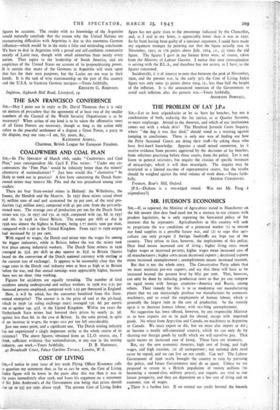COALOWNERS AND COAL PLAN Stn,—In The Spectator of March 16th,
under " Coalowners and Coal Plan," your correspondent Mr. Cecil F. Pike writes: "Under any cir- cumstandes the 'Foot Plan' would be infinitely better than the miners' alternative of nationalisation! " just how would this " alternative " be likely to work out in practice? A few facts concerning the Dutch State- owned mines may interest Mr. Pike and the less prejudiced among your readers.
There are four State-owned mines in Holland: the Wilhehnina, the Emma; the Hendrik and the Maurits. In 1937 these mines raised about 83 million tons of coal and , accounted for 59 per cent, of the total pro- duction (143 million tons), compared with 41 per cent, from the privately- owned ones. The average cost of production per ton for the Dutch State mines was I35. in 5937 and I55. in 1938, compared with 14s. 8d. in 1937 and I6s. in 1938 in Great Britain. The output per shift or day in 1936 was almost the highest in. Europe, being 1.77 metric tom per man, compared with 1.196 in the United Kingdom. From 1927 to 1936 output had increased by 55 per cent.
With regard to wages, the Dutch coal miner tops the wages list among the bigger industries, while in Britain before the war the miner took 81st place among industrial workers. The Dutch State miners in 1936 averaged. 9s. lid per shift Of -day against 99. 83d. in Britain (figures based On the conversion of the- Dutch national currency with sterling at the current rate of exchange). It. appears to be reasonably clear that the wage rates in the Dutch coal industry were at least as high as in Britain before the war, and that annual earnings were appreciably higher, because there was no short time working.
Figures for accidents are equally _revealing. The number of fatal accidents among underground and surface workers in 1936_was 0.51 per thousand persons employed, compared with .1.432 per thousand in England.
How, it will be asked, has the consumer benefited from this State- owned enterprise? The answer is in the price of coal at the pit-head, which in 1936 (at ruling exchange rates) averaged 133. 6d. per metric ton as against 145. 43d. in the United Kingdom. Within ten years the Netherlands State mines had lowered their prices by nearly 2s. 3d. against less than 6d. in the case of Britain. In the same period, in spite of an increase in wages, the wages cost per Ion fell considerably.
Just one more point, and a significant one. The Dutch mining industry has not experienced a single important strike in the whole Course of its existence! The above figures; obtained from an I.L.O. source, are, I think, sufficient evidence that nationalisation, at any rate in the mining


























 Previous page
Previous page